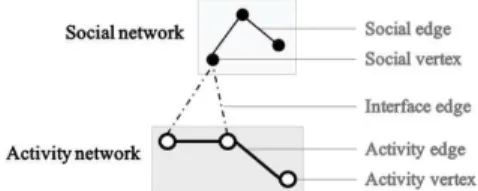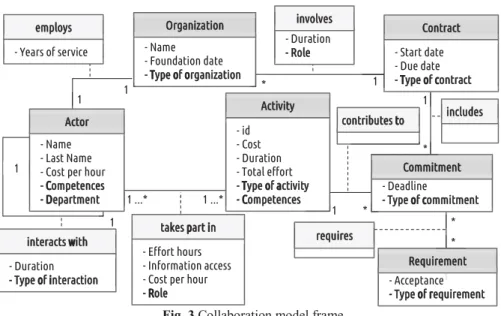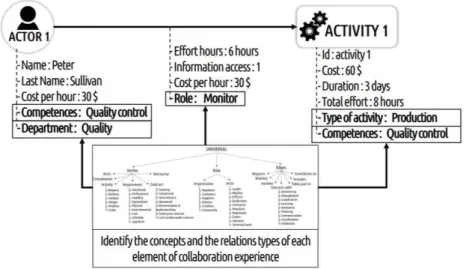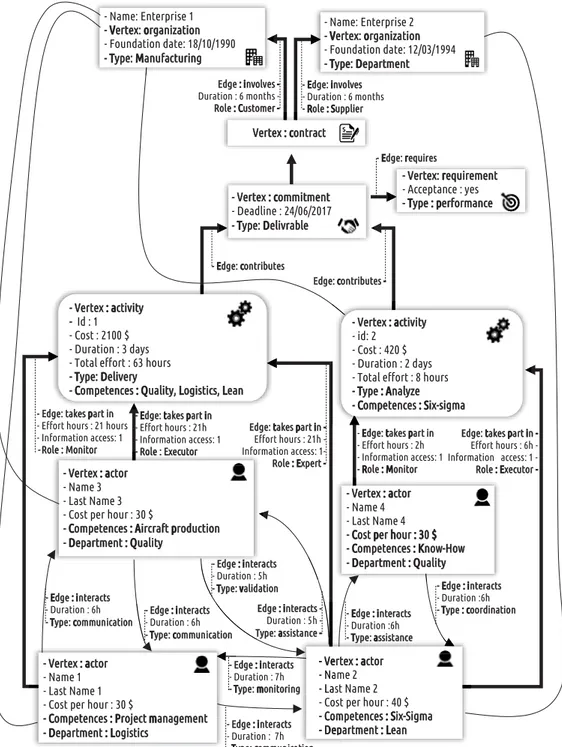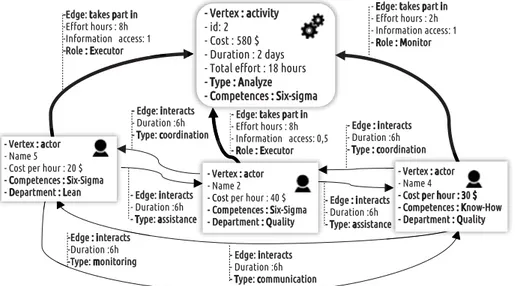OATAO is an open access repository that collects the work of Toulouse
researchers and makes it freely available over the web where possible
Any correspondence concerning this service should be sent
to the repository administrator:
tech-oatao@listes-diff.inp-toulouse.fr
This is an author’s version published in: http://oatao.univ-toulouse.fr/21750
To cite this version:
Meléndez, Sofia and Coudert, Thierry
and Geneste, Laurent
and Romero Bejarano, Juan C. and De Valroger, Aymeric
Formalization and reuse of collaboration experiences in industrial
processes. (2019) In: Complex Systems Design & Management, 18
December 2018 - 19 December 2018 (Paris, France).
Open Archive Toulouse Archive Ouverte
Diana Sofía Meléndez; Juan Romero; Aymeric De Valroger Axsens bte
20 Impasse Camille Langlade, 31400 Toulouse, France
{sofia.melendez ; juan.romero ;aymeric.devalroger}@axsens.com Thierry Coudert ; Laurent Geneste
INP-ENIT, University of Toulouse
47 Avenue d'Azereix, 65000 Tarbes, France {thierry.coudert ; laurent.geneste}@enit.fr
Formalization and reuse of collaboration
experiences in industrial processes
D. Meléndez , T. Coudert, L. Geneste, J. C. Romero Bejarano, A. De Valroger
Abstract Collaboration is a key factor for carrying out activities in industrial processes and an efficient collaboration is essential to accomplish an overall improvement of any process. In this article, we introduce a collaborative process-modeling framework, which allows evaluating collaboration throughout all the activities of an industrial process. The proposed framework uses experience management notions towards the creation of a repository of collaboration experiences. This experience base facilitates the reuse of past experiences to support decision making for the organization and execution of future collaborations. The article concludes by discussing the contributions and limitations of the proposed collaboration model.
1 Introduction.
To confront the upcoming challenges of the market, companies must continuously evolve and improve. In order to succeed in this endeavor, an effective collaboration between companies and between people plays a central role to improve or optimize processes.
At the companies level, collaboration can be defined as the cooperative effort between two or more entities striving towards a common goal (Durugbo et al. 2011). In the last decades, the rise of outsourcing has been a strong trend for industrial firms and therefore, collaboration between companies plays a key role in the achievement of successful results in industrial processes.
At the people level, projects and industrial processes are composed by different tasks, and participants with specific characteristics contribute to these tasks. For that, participants must work together based on durable relationships and strong commitments to reach a common goal with the aim of pooling expertise and standardizing tasks (Durugbo et al. 2011).
In order to improve performance in industrial processes, the capitalization and use of past experiences is a key aspect (Skyrme 2007). More specifically, experience
and knowledge management applied to collaboration processes can create value in inter-organizational activities (Lambert et al. 1999) .
The overall aim of this paper is to propose a conceptual collaboration model that allows capitalizing how individuals collaborate in a process in order to reuse these collaboration experiences in the future.
This article is organized as follows: section 2 describes the related works on collaboration characterization and Knowledge Management Systems applied to collaboration in processes. In Section 3, the collaboration model and capitalization methodology are presented. Finally, section 4 presents the conclusions and discusses some limitations of the proposed model and perspectives for future research.
2 Literature Review.
Collaboration has been analyzed in several studies due to its impact on the enterprise success. This section presents the current research of two key domains in our model: collaboration characterization in industrial processes and Knowledge Management Systems applied to collaboration in processes.
2.1 Collaboration characterization in industrial processes
Collaborative Engineering (CE) emerged in the 1990s as an approach to structure the collective aspects of product and system design (Segonds et al. 2014). CE is defined as a technological approach that supports distributed, multi-disciplinary, and multi-organizational teams during the product development and manufacturing processes (Ma, Chen, and Thimm 2008).
The main characteristic of CE is that the different project stakeholders are requested to work together and interact with each other in order to reach an agreement and make shared decisions (Segonds et al. 2014). To breakdown the wall between functional design and industrial design and to perform the design process with a unique team, (Mas et al. 2013) emphasize the importance of creating a new methodology that needs new procedures and new PLM tools. CE works if the team members’ abilities are combined to perform complex tasks in a short time, which individual members will not be able to achieve on their own (Gogan et al. 2014).
On the other hand, Collaborative Business Processes Management - cBPM - intervenes across organizational boundaries involving actors from inside or from outside an organization (Hermann et al. 2017). In addition, (Roa et al. 2015) complement the definition with the inclusion of inter-organizational systems interactions.
Collaboration in organizations can be analyzed as complex networks as shown in Fig. 1 (Durugbo et al. 2011). They propose a mathematical model that enables to
study how individuals in organizations work together to solve a problem or achieve a common goal. The two main objectives of this model are: i) to define topologies for the information structure and ii) to propose quantitative indicators for the information behavior that can be used to characterize collaboration in organizations. This model focuses on information flow but it does not consider other elements of the collaboration context such as contracts, commitments and indicators of quality among others.
Fig. 1 Collaboration as a graph (Durugbo, 2011).
From Durugbo’s mathematical model three indicators of collaboration have been proposed: Team work scale; Decision making scale; Coordination scale. The team work scale measures the ease with which social vertices can pool resources, it is calculated by aggregating two mathematical measures: the clustering coefficient and the centrality degree of the collaboration graph. This indicator allows for assessing the activity of an actor and interconnectedness within a cluster for teamwork. The decision making scale measures the ease with which social vertices can make choices, it is calculated by aggregating the clustering coefficient and the closeness degree. This indicator assesses the ease with which an actor within the intra-organizational network can make decisions based on the interconnectedness and connections for relationships. Finally, coordination scale measures the ease with which social vertices can harmonize interactions; it is calculated by aggregating the closeness and the centrality degree. These indicators permit to characterize the performance of collaboration between actors to perform activities.
2.2 Knowledge Management applied to collaboration in processes
Principles of Knowledge Engineering (KE) have been introduced in cBPM towards a collaboration model based on ontologies and deduction rules in order to build a collaboration information system (Rajsiri et al. 2010). This model is a collaborative process model that describes interactions and information exchanges between business partners. This work proposes a higher abstraction level of a given collaboration. It allows characterizing collaboration from existing knowledge. Therefore, the precision of collaboration characterization strongly relies on the quantity and quality of the knowledge provided by business partners (i.e. the experts). High-level knowledge such as general deduction rules are difficult to implement in specific contexts. Thus, it is necessary to have a detailed level of
knowledge modelling consistent with an actual context in order to be able to deduce general knowledge based on actual experiences.
The systematic reuse of experience in industry allows making better use of experiences during an industrial process. Experience Management (EM) supports the capture, storage, search, and retrieval of past experiences (De Mendonça Neto et al. 2001) and its ultimate goal is experience reuse (Bergmann 2002).
Accompanying this logic of experience reuse, Case Based Reasoning (CBR) is an approach that facilitates the resolution of problems by recovering, adapting and reusing previous experiences. This approach requires the characterization of the context in which the experiment took place and the lesson learned in this context for solving a given problem (Kolodner 1993).
In summary, the main purpose of this paper is the use of Experience Management principles in order to establish a model of collaboration experience, capitalize the contributions of each actor throughout the activities of a collaborative process and reuse experiences to improve the future execution of the process or the definition and execution of similar processes.
In the next section we will describe the experience feedback process, the elements of the collaboration model and an illustrative application based on a real process execution.
3 Experience feedback process for collaboration
3.1 Experience feedback process
The main goal of this study is to propose an experience feedback process in order to capitalize experiences of collaboration in industrial processes and to reuse them to define future collaborations. The capitalization of an experience is done for all activities of a process as shown in Fig. 2 , it is formalized through the elements of the knowledge base in order to standardize the capitalization and facilitate the future reuse of past experiences.
In order to facilitate the reuse of experiences, it is necessary to define a collaboration model corresponding to a generic experience frame. This collaboration model is stored in a knowledge base. Every collaboration experience will be an instance of this model. In order to define the characteristics of a collaboration experience without ambiguity, it is necessary to standardize the main concepts and to store them. Therefore, the knowledge base also contains a taxonomy of concepts that are used to characterize the different elements of the experience. Once an experience has been properly defined from the available knowledge, it is stored into the Experience Base (EB). It is important to be able to capitalize the planned collaboration and the actual one within an experience, since this will allow to compute some performance indicators corresponding to the experience. When a process has to be planned for a new execution, the prior experiences stored into the Experience Base, and corresponding to the activities of the process, can be reused.
The collaboration model and the taxonomy are described in the next section.
3.2 Collaboration Model
This section describes the collaboration model that allows standardizing the experience capitalization and which is used by the experience feedback process. The concepts organized in the taxonomy are also presented. An experience is modeled by an oriented graph which is based on the collaboration model as shown in Fig 3.
The proposed collaboration model is based on the execution of an industrial process. Different organizations can contribute to the execution of several activities of an industrial process in order to reach for defined goals. These goals are represented in our model by commitments and they must accomplish one or several requirements. In order to formalize the different participation of the organizations, they are governed by contracts. The interaction between the organizations to fulfill the commitments of a contract engenders an industrial process. It is a structured, managed and controlled set of activities with the purpose of transforming inputs into specified outputs. During the execution of the process activities, actors collaborate in order to reach the process commitments. Every actor exerts different roles and contribute to one or several activities throughout the process.
Two or more organizations are involved by a contract in order to achieve one or several commitments, and the contract includes all the agreed commitments. Furthermore, these commitments must contribute to fulfill one or several requirements. In the model this relation is named requires. The commitments are the result of one or several activities of the process, this means that one activity
contributes to one or several commitments. At this level, there are the interactions
between people to execute an activity. Thus, an actor takes part in one or several activities and also an actor interacts with one or several actors during the execution of the activity. Fig 3 shows the set of elements of the proposed collaboration model.
Fig. 3 Collaboration model frame
An organization is a group of people, structured in a specific way to achieve shared commitments.For this element, we must identify the name, the foundation date and the type of organization. A contract represents one or several agreements where an organization provides goods or services to another organization, it could be a verbal contract or a written contract. For this element, we must identify the start date, end date and the type of contract. A commitment in the proposed collaboration model represents the output of a process activity. It is characterized by a type of commitment classified in: product, report, service and systems for example. A requirement is a specific need that the commitments have to meet. For this element, we must identify the type of requirement. An activity of an industrial process describes the work which transform one or several inputs in intermediate or final outputs of the process.The following information must be identified for each activity: cost, duration, total effort, and type of activity. The cost attribute includes the cost of all actors who participate in the activity and others costs such as material cost, transportation cost, etc. The duration attribute is the difference between the start date and the due date. The total effort is the sum of all workloads in person-hours needed to carry out the activity. An actor a person who participate in one or more activities of an industrial process.They are characterized by: name, cost per hour, department and one or more competences.
For the relations between vertices, the main relations are: Takes part in,
Interacts, Includes, Contributes, Involves, Requires and Employs.
The relation “Takes part in” is the relation between an actor and an activity. It is the contribution of the actor for a given activity and it is characterized by the total number of hours required by the actor to execute his/her contribution otherwise the actor’s effort. Another characteristic is the information access. We propose to measure this indicator with a number between the 0 and 1. The value 1 indicates that the the information necessary to carry out an activity is easily obtainable. The
- Acceptance - Type of requirement Requirement - Start date - Due date - Type of contract Contract - Name - Foundation date - Type of organization Organization - Deadline - Type of commitment Commitment - id - Cost - Duration - Total effort - Type of activity - Competences Activity - Name - Last Name - Cost per hour - Competences - Department Actor - Duration - Type of interaction interacts with - Years of service employs - Duration - Role involves includes requires - Effort hours - Information access - Cost per hour - Role takes part in contributes to 1 1 1 ...* 1 ...* * 1 * * 1 * 1 * 1 1
value 0 means that it is impossible to access to the information. The relation
“Interacts” is the relation between an actor i and actor j. The relation “Contributes” is the relation between an activity and a commitment, it indicates
which activity contribute to a commitment. The relation “Requires” is the relation between a commitment and a requirement, it represents the requirements that must be met. The relation “Involves” represents the relation between an organization and a contract. It is characterized by the duration and the organization’s role for a specific contract. The relation “Includes” is the link between a contract and a commitment. A contract may have one or several commitments. The relation “Employs” represents the link of work between an actor and an organization. An actor cannot have a direct link to two or more organizations.
The attributes of vertices and edges must be standardizing in order to facilitate the future reuse. Then, a taxonomy of concepts allows this standardization and it ensures an accurate capitalization.
3.3 Taxonomy of concepts
Each vertex and some edges must be characterized from a taxonomy of concepts. An example of taxonomy, which can be used for the characterization of collaboration experiences, is represented in Fig. 4. A taxonomy is a hierarchical structure described through relations between concepts included in the hierarchy (Van Rees 2003). Taxonomies create a consistent representation of concepts through their structuration into a tree according to their similarity (Jabrouni et al. 2011).
Fig. 4 Extract from taxonomy of concepts
In our work, taxonomies are defined for some attributes in order to characterize the collaboration experiences and facilitate their retrieval into the experience base where all experiences will be stored. This will be develop in section 3.4. An example of taxonomy for collaboration experiences is represented in Fig. 4. This taxonomy of concepts is based on existing taxonomies proposed by (System Requirements -
à Request à Delivery à Analyze à Design à Produce à Order Role Actor Acto Organization à Leader à Monitor à Diffuser à Contractor à Regulator à Negotiator à Expert à Operator à Technical bond à Le à Mo à Di à Co à Re à Ne à Regulator à Customers à Suppliers à Sponsor à Creditors à Community UNIVERSAL Vertex Activity Actor Orga Commitment vity Requirement Contract
Entreprise est very ze gn uce à Functional à Performance à Usability à Operational à Physical à Environmental à Cost à Schedule à Logistical Employspl Edge Involves Requires Contribute to Includes Takes part in Interacts with à Monitoring à Management à Cooperation à Learning à Assistance à Planning à Communication à Coordination à Validation à à à à à tal à Teaming à Consortium à Joint venture à Sponsored à Verbal contract à Fixed-price contract à Cost reimbursable contract
SEBoK, 2015) for requirements, (Boucher et al, 2007) for actor’s roles and (Mayer et al. 2012) for contracts.
3.4 Collaboration Experience building
The knowledge base contains the collaboration model frame to structure a collaboration experience, and the taxonomy to characterize, with validated and standard concepts, all the elements of a collaboration experience. The KB is essential in our model because it facilitates the experience formalization and reuse. In addition to the elements and their interactions previously described, it is necessary to distinguish two stages of the collaboration experience: the planned collaboration and the actual collaboration.
Fig. 5 Example of instantiation and link with taxonomy for two elements
The first stage is the planned collaboration where all the necessary actors, activities, commitments, requirements, contracts and organizations of the process to execute are included. They are planned a priori. Fig. 5 shows an example of an instantiation for one vertex actor and one vertex activity. For each element, there are certain attributes for which their values will be found in the proposed taxonomy. In Fig. 5, for the vertex activity 1, the given value for the attribute competence is “Quality control” and the given value for the attribute type of activity is “Production”. Both values are coming from the taxonomy of concepts.
Fig. 6 represents an example of a planned collaboration instance. It is the
Fig. 6. Example of planned collaboration experience
- Edge: takes part in - Effort hours : 2h - Information access: 1 - Role : Monitor - Edge: takes part in
- Effort hours : 21 hours - Information access: 1 - Role : Monitor
- Edge: takes part in - Effort hours : 21h - Information access: 1 - Role : Executor - Edge : interacts - Duration : 6h - Type: communication - Name: Enterprise 1 - Vertex: organization - Foundation date: 18/10/1990 - Type: Manufacturing - Name: Enterprise 2 - Vertex: organization - Foundation date: 12/03/1994 - Type: Department Vertex : contract - Vertex : commitment - Deadline : 24/06/2017 - Type: Delivrable d k - Vertex : activity - Id : 1 - Cost : 2100 $ - Duration : 3 days - Total effort : 63 hours - Type: Delivery
- Competences : Quality, Logistics, Lean
- Vertex : activity - id: 2 - Cost : 420 $ - Duration : 2 days - Total effort : 8 hours - Type : Analyze - Competences : Six-sigma
ole : Monitor - Role : Executor
- Vertex : actor - Name 3 - Last Name 3 - Cost per hour : 30 $
- Competences : Aircraft production - Department : Quality
- Vertex : actor - Name 1 - Last Name 1 - Cost per hour : 30 $
- Competences : Project management - Department : Logistics
- Vertex : actor - Name 2 - Last Name 2 - Cost per hour : 40 $ - Competences : Six-Sigma - Department : Lean
- Vertex : actor - Name 4 - Last Name 4 - Cost per hour : 30 $ - Competences : Know-How - Department : Quality - Vertex: requirement - Acceptance : yes - Type : performance Com - Depppp - Edge : interacts - Duration : 7h - Type: communication - Ve - Na - Last - Edge : interacts - Duration : 7h - Type: monitoring - Edge : interacts - Duration :6h - Type: assistance - Edge : interacts - Duration :6h - Type : coordination - Edge : interacts - Duration : 6h - Type: communication - Edge : interacts - Duration : 5h - Type: validation Edge : interacts Duration : 5h -Type: assistance - Edge: takes part in Effort hours : 21h -Information access: 1Role : Expert
Edge: takes part in Effort hours : 6h Information access: 1 Role : Executor -- Edge: contributes Edge: contributes -- Edge: requires Edge : involves Duration : 6 months Role : Customer -- Edge: involves - Duration : 6 months - Role : Supplier
The second level is the actual collaboration. It means the actual information of the process execution. The Fig. 7 represents the changes of the execution of planned collaboration experience, which mainly concerns the activity 2; the other elements have not been represented because they are identical to the planned experience. This allows the calculation of performance indicators in order to identify the gap between the planned collaboration experience and the actual collaboration experience. These performance indicators are commitment acceptance, process delay and respect of the budget among others.
Fig. 7. Example of an actual collaboration experience (activity 2)
The second step of the proposed approach is the storage in the Experience Base (EB) (after validation) of the planned collaborative experience, the actual collaborative experience and the indicators. When the EB has a significant number of experiences, the information can be reused to facilitate the decision making process of future collaborations. The reuse of experiences is described in the next section.
3.5 Collaboration Experience reuse
The main objective of the Experience Feedback Process is the reuse of past experiences to improve current situations. In order to fall within this reuse logic, we have proposed a characterization of the context of a process by using a labelled graph. In the section 3.2, we defined a collaboration model frame of a process that forms the basis of the search mechanism for similar experiments. This frame allows creating an experience base and to develop a mechanism of research to build on previous experiences. These experiences can then be used to improve the selection
- Edge: interacts - Duration :6h - Type: communication -Edge : interacts -Duration :6h -Type: monitoring - Vertex : activity - id: 2 - Cost : 580 $ - Duration : 2 days - Total effort : 18 hours - Type : Analyze - Competences : Six-sigma
- Vertex : actor - Name 2 - Cost per hour : 40 $ - Competences : Six-Sigma - Department : Quality
- Vertex : actor - Name 4 - Cost per hour : 30 $ - Competences : Know-How - Department : Quality - Edge: takes part in
- Effort hours : 8h - Information access: 0,5 - Role : Executor
- Edge: takes part in - Effort hours : 2h - Information access: 1 - Role : Monitor - Edge : interacts - Duration :6h - Type : coordination - Cos - Com - De - Edge : interacts - Duration :6h - Type: assistance - Vertex : actor - Name 5 - Cost per hour : 20 $ - Competences : Six-Sigma - Department : Lean
-Edge: takes part in -Effort hours : 8h -Information access: 1 -Role : Executor - Edge: interacts - Duration :6h - Type: coordination Nam - Cost p - Com - Depa - Edge: interacts - Duration :6h - Type: assistance
of key actors for similar processes. This choice could be done by one of several criteria of the collaboration frame and the characteristics of the actor. For example, given a non-quality situation in an industrial process, the process of problem solving can be improved thanks to the experience base where the actors of the process who have previously participated in the problem solving can be identified and filtered by more specific characteristics such as product type, years of experience or competences.
5 Conclusion
Due to the increasing complexity of industrial processes with outsourcing activities, collaboration has become one of the relevant areas of performance measurement. The analysis of the collected literature indicates that there is a lack of methodologies for collaboration characterization between companies based on the characterization and performance of team collaboration, as well as an absence of a formal inclusion of experience feedback process.
In this article, a collaboration model for experience collaborations characterization has been defined. This model allows characterizing the collaboration experience in two stages: (i) team stage and (ii) company stage. The collaboration model proposed within the formalization of elements such as contracts, commitments and requirements is novel. Also, this article has shown the importance of experiences capitalization and reuse, in order to improve and to facilitate future collaborations in industrial processes.
Despite the model described in this article allows the calculation of performance indicators focused on requirements, activities and actors, it is important to notice that the quality of the collaboration process cannot be evaluated. Therefore, the perspectives of this research are to propose some new indicators which will reflect how good is the collaboration within an experience. This will enable to characterize how two or more organizations are collaborating within the experiences.
From these quality indicators, it will be possible to help to define efficient associations of organizations following the past experiences with regard to collaboration.
Finally, the experience feedback process is still at a preliminary stage and requires further development. The first axis of development is the definition of (i) a method to reuse experiences and (ii) a mechanism to generalize several experiences in knowledge.
References
1. Bergmann, R.: Experience Management: Foundations, Development Methodology, and Internet-Based Applications. Heidelberg: Springer-Verlag. (2002).
2. Boucher, X., Bonjour, E., Grabot,B: Formalisation and Use of Competencies for Industrial Performance Optimisation: A Survey. Computers in Industry 58. 2 (2007) 98–117.
3. Durugbo, C., Hutabarat, W., Tiwari, A. and Alcock, J. : Modelling Collaboration Using Complex Networks. Information Sciences 181. 1 (2011) 3143–3161.
4. Gogan, L., Popescu, A., Duran,V.: Misunderstandings between Cross-Cultural Members within Collaborative Engineering Teams. Procedia-Social and Behavioral Sciences 109. (2014) 370–374.
5. Hermann, A., Scholta, H., Bräuer, S., Becker, J.: Collaborative Business Process Management-A Literature-Based Analysis of Methods for Supporting Model Understandability. Proceedings Internationale Tagung Wirtschaftsinformatik 13. (2017)286-300.
6. Jabrouni, H., Kamsu-Foguem, B., Geneste, L., Vaysse,C.: Continuous Improvement through Knowledge-Guided Analysis in Experience Feedback. Engineering Applications of Artificial Intelligence 24. 8 (2011) 1419–1431.
7. Kolodner, J.: Case-Based Reasoning. Morgan Kaufmann. (1993).
8. Lambert, D., Emmelhainz, M., Gardner, J.: Building Successful Logistics Partnerships. Journal of Business Logistics 20. 1 (1999)165.
9. Ma, Y.-S., Chen, G., Thimm, G.: Paradigm Shift: Unified and Associative Feature-Based Concurrent and Collaborative Engineering. Journal of Intelligent Manufacturing 19. 6 (2008) 625–641.
10. Mas, F., Menéndez, J., Oliva, M., Ríos, J.: Collaborative Engineering: An Airbus Case Study. Procedia Engineering 63. (2013) 336–345.
11. Mayer, D., Warner, D., Siedel, G., Lieberman, J.: The Law, Sales, and Marketing. (2012)
12. De Mendonça Neto, M.G., Seaman, C., Basili, V.R., Kim, Y.M.: A Prototype Experience Management System for a Software Consulting Organization. SEKE. (2001) 29–36.
13. Rajsiri, V., Lorré, J.P., Benaben, F., Pingaud, H.: Knowledge-Based System for Collaborative Process Specification. Computers in Industry 61. 2 (2010) 161–175. 14. Roa, J., Chiotti, O., Villarreal, P.: Detection of Anti-Patterns in the Control Flow of
Collaborative Business Processes. Simposio Argentino de Ingeniería de Software -ASSE 44. (2015).
15. Segonds, F., Mantelet, F., Maranzana, N., Gaillard, S.: Early Stages of Apparel Design: How to Define Collaborative Needs for PLM and Fashion?. International Journal of Fashion Design, Technology and Education 7. 2 (2014) 105–114.
16. Skyrme, D.: Knowledge Networking: Creating the Collaborative Enterprise. Routledge. (2007).
17. Pyster, A., Olwell, D. H., Hutchison, N., Enck, S., Anthony Jr, J. F., & Henry, D. Guide to the systems engineering body of knowledge (SEBoK) v. 1.0. 1. Guide to the Systems Engineering Body of Knowledge (SEBoK). (2012).
18. Van Rees, R.: Clarity in the Usage of the Terms Ontology, Taxonomy and Classification. CIB REPORT 284. 432 (2003) 1–8.
